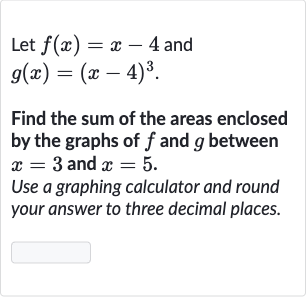Full solution
Q. Let and Find the sum of the areas enclosed by the graphs of and between and .Use a graphing calculator and round your answer to three decimal places.
- Understand the Problem: First, we need to understand the problem. We are asked to find the sum of the areas between two curves, and , from to . To do this, we will calculate the definite integral of the absolute value of the difference between the two functions over the interval .
- Set Up Integral: Let's set up the integral to find the area between the two curves. The area can be found by integrating the absolute value of the difference between and from to :
- Determine Top Function: We need to determine the function that is on top (greater -value) over the interval . Since is a linear function and is a cubic function with the same root at , we can expect to be below near the root. However, we should verify this by evaluating the functions at a point in the interval, such as .Since , is above in the interval .
- Write Integral: Now we can write the integral without the absolute value, as we know is above :
- Calculate Integral: Let's calculate the integral:Now we need to evaluate this antiderivative at the bounds and and subtract the results.
- Evaluate at : Evaluating the antiderivative at :
Evaluating the antiderivative at :
Now we subtract from to find the area:
However, this calculation is incorrect because the antiderivative was not computed correctly. There is a math error in the antiderivative expression and its evaluation.

